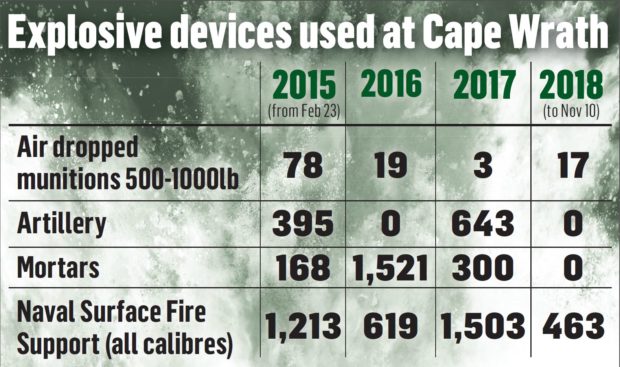Military budget cuts have been blamed for a dramatic fall in the use of a key weapons training range in the Highlands.
Data released to The Press and Journal shows that the number of munitions detonated at the Cape Wrath facility plummeted by 80% from 2,449 in 2017 to 480 this year.
Only 39 bombs have been dropped from the air at the range over the last three years, compared to 78 in 2015 alone.
And no artillery or mortars were tested at Cape Wrath in 2018, with the site almost exclusively used to for Naval Surface Fire Support training last year, but even that was at its lowest level in the period.
One defence industry insider claimed that this decline would be the “new norm” as budget cuts bite and the fleet of Tornado GR jets, previously based at RAF Lossiemouth, is withdrawn from service.
Another expert, military analyst and author Tim Ripley, described the figures as “interesting” and also said he believed they reflected a drop in military spending by the UK’s forces.
He said: “The Cape Wrath one seems to reflect a decline in live weapon training being run by the UK armed forces.
“It is a MoD (Ministry of Defence) owned rage used for routine training and that seems to be in decline because of the cost.
“They used to run two big exercises each year, called Joint Warrior (JW), which always ended with a big live fire phase at Cape Wrath but now the MoD struggles to run one JW a year.
“This year they cancelled the autumn JW and sent all the troops and ships to Oman instead for Exercise Saif Sareea 3.”
Mr Ripley added: “Times are tough and there is not as much money for training.”
Jamie Stone, Liberal Democrat MP for Caithness, Sutherland and Easter Ross, expressed alarm at the figures.
He said: “Joint Warrior is one of the largest military exercises in Europe. The loss of this routine exercise at Cape Wrath is not just a loss for thousands of military personnel, but a disappointing loss for our local economy too.
“Conservative ministers must shoulder the blame for this, but also answer claims that ‘there is not as much money for training’.
“The first duty of government is to defend its citizens. Conservative cuts must not compromise that.”
Established in about 1933 as a naval gunnery and bombing range, Cape Wrath is used for a wide variety of field fire and dry training exercises across 25,000 acres of isolated upland moorland.
It is the only range in Europe where land, sea and air training activities can be conducted simultaneously and where the RAF can train using live 1,000lb bombs.
An MoD spokesman said: “It’s not correct to say that the lower number of munitions used on the range is related to funding.
“Fewer weapons have been used on Cape Wrath this year because live firing training has taken place elsewhere, mainly on Exercise Saif Sareea, the largest joint exercise of its kind in 17 years.”










